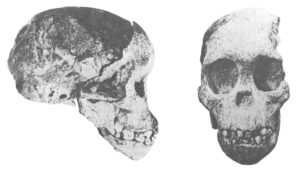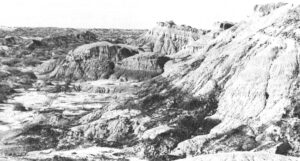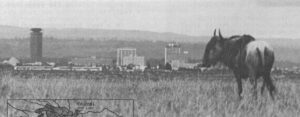Boyce Rensberger
- 1973

Fellowship Title:
- Man's Acheological Past and Ecological Present in Africa
Fellowship Year:
- 1973

Olduvai Gorge: Showcase of Early Man’s Technology
It is 5:30 in the morning and, looking east, I can see the darkness lifting over the distant rim of the wide Ngorongoro Crater. The hyenas have stopped whooping in the gorge — Olduvai Gorge — that falls away at my feet. The wind whistles through thorn bushes along my edge of this great ravine. It is cool and strangely quiet. The starry sky will soon be ablaze with equatorial heat. But, in this fragile dawn between primeval night and reassuring day, the bones that lie buried here seem to stir. The sharply layered deposits of Olduvai Gorge, 160 miles southwest of Nairobi in northern Tanzania, were created by alternating deposition of take sediments and volcanic ash from eruptions along the Rift Valley. The gorge, cut by a river and widened by erosion, meanders some 25 miles with one major fork. Over 130 sites along its length have yielded bones and/or tools ranging in age from 10,000 years to nearly two million years. Was it like this a million years ago — or two million

The Mysterious Fossil Mines of South Africa
As readers of Robert Ardrey’ s African Genesis may recall, the first solid suggestion that man originated in Africa came in the 1920s when Raymond Dart painstakingly chiseled the fossilized skull of a pre-human child from a block of South African limestone. Two views of Raymond Dart’s Taung baby, the first ape-man ever found. It may have lived among an isolated population of pre-humans who survived tong after men evolved elsewhere. Dart, then a young professor of anatomy at a Johannesburg medical school, spent four years scratching away the stone that enveloped the skull. He revealed, for the first time anywhere, a creature that looked like a possible ancestor to the human species, a link between hominids — the family of man — and pongids — the family of apes. Today in South Africa Dart’s successors are still chipping away more rock to expose more pre-human fossils and they are studying the South African sites in new ways that are leading to some startling findings. In eastern Africa — at Olduvai Gorge, East Rudolf and

The Omo Research Expedition: Exploring the World of Early Man
The Omo Valley, Ethiopia Out here in a remote corner of Ethiopia, under the burning African sun, they are learning what the world was like when man was born. Near the banks of the ancient Omo River, unlike any other place in the world, uplifting of the earth’s crust and subsequent erosion has fanned out the layers of geologic history so that it is possible to walk in a day through three million years of human evolution – the critical span from about 1. 5 million years ago to nearly 4.5 million years ago. Today a tossed and eroded badlands, the Omo Valley was, in the days when man first evolved, a flat and dry grassland dotted with trees. Then as now, the Omo River flowed through the region, its banks fringed with a verdant forest. It was during this period that two legged, apelike but manlike creatures walked the grassy savannas of eastern Africa and, under the pressures of changing environmental conditions that demanded new techniques of survival, evolved into human beings. Every

The ‘Elephant Slums’ of Tsavo National Park
Voi, Kenya Probably no other controversy has done more to divide the ranks of conservationists around the world or more to cripple ecological research in East Africa than that involving the elephants of Tsavo. Because of pressures outside the huge 8,300 square -mile Tsavo National Park, thousands of elephants have been crowding into the sanctuary, swelling the population to somewhere between 20,000 and 30,000, and making it the largest remaining concentration of elephants in the world. Because elephants eat so much and push down so many trees in the course of their activities, large concentrations can devastate an area. Tsavo, once a lush land of dense bush and trees is today a sad landscape of bare ground and struggling grasses, strewn with the skeletons of downed trees. Because the park receives very little rain, some scientists have said the destruction could eventually turn Tsavo into a desert, providing so little food that most of the elephants would eventually starve to death. The long-term result could be a “population crash” that would wipe out elephants in

Success is Spoiling Nairobi’s Suburban Wilderness
Nairobi, Kenya From the traffic jams and high-rise office buildings of downtown Nairobi it is just five miles to the Pleistocene age of mammals. On the outskirts of this burgeoning metropolis of nearly 600,000 there remains a remarkable concentration of wildlife, the like of which has not been seen in most of the world for thousands of years. Protected within Nairobi National Park, a mere 44 square miles, leopards prowl the forest at night, thousands of antelopes graze the plains by day and, within sight of the city’s taller buildings, the rhinoceros — a true relic of prehistoric times — plods through the bush. Less than five miles from downtown Nairobi, a wildebeest grazes in East Africa’s most unusual national park. The city and suburbs (see map) hem the park on all but one side. Continuing sprawl threatens to encircle the park. At the height of the dry season, when animals from the largely unpopulated region to the south crowd toward the park’s waterholes, more than 18,000 mammals of 78 species live in the
